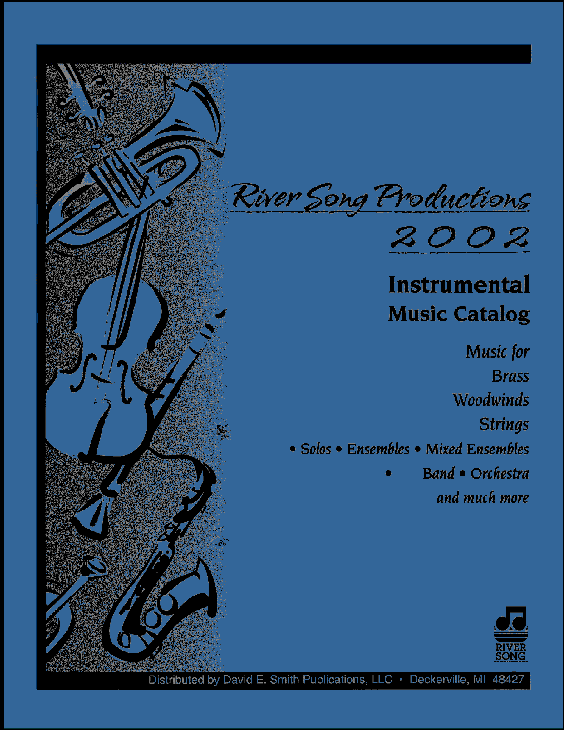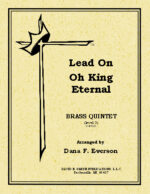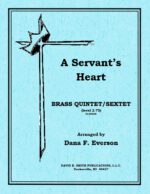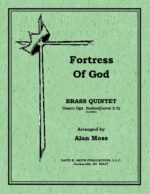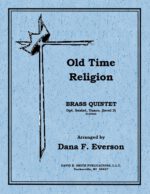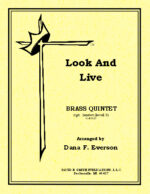| Instrument | |
|---|---|
| Level | 3 |
| Occasion | |
| Tune Name | |
| Theme | The Old Rugged Cross |
| Hymn First Line | On a hill far away, stood an old rugged cross, |
| Writer | |
| Composer | |
| Publisher | |
| Copyright | 1994 |
| Key | Ab, Db |
| Meter | 3-4 |
| Idiom | Sax quintet |
| Form | Song (ternary) |
The Old Rugged Cross
$14.95
2 asx, 2 tsx, bsax,
Related products
-
Like A River Glorious
$12.00This quintet (opt. Sextet) begins with extraneous motifs leading into the first statement of the theme in the low brass offset by answering material in the trumpets. The pieces continues in this question and answer texture passing motivic material around the parts. Then in a transition mimicking the beginning a modulation takes place where the theme is more expressive and becomes more aggressive leading up to a majestic coda where it ends on a thought-provoking conclusion.
-
Lead On O King Eternal
$10.00A traditional brass quintet with opt. trumpet for horn and extra baritone for use as a sextet. The introduction uses extraneous material where it leads in the first theme by the trombone until the theme is passed around in fragments until the them is taken over by the trumpets, and the trombones. A modulation takes place where the theme is in the trombones with flourishes in the trumpets. The trumpets now take the theme with flourishes in the middle voices until the piece ends with a declamatory statement.
-
A Servant’s Heart
$10.00A brass quintet, optionally sextet, begins with a soulful trombone solo joined with the remainder of the lower brass instrument only to be taken over by the trumpets. The middle section uses a punctuated accompaniment for nice variety only to migrate to the flowing style of the beginning. It then ends in solemn repose.
-
-
Old Time Religion
$12.00A traditional brass quintet with an optional baritone part which allows to be a sextet as well. The beginning is active establishing a happy beginning to the piece. Then all the parts are in straight harmonies and then become fragmented. A modulation takes place allowing the lower voices to carry the tune. Then a tuba sola solo commences with light upper parts decorating the lines, until the parts fragment. This concludes with a modulation with motivic statements. After a brief intermission the piece takes off again with the tune in the lower voices and the trumpets add a flurry descants. As the piece comes to a close more and more voices add to the mix until the pieces adds a solid, grand statement.
-
Only A Sinner
$10.00A woodwind quartet for Flute, oboe, and two clarinets with optional parts for flute and alto sax. Plus a set of fifth parts for bassoon or bass clarinet can allow for the piece being a quintet. The first statement is in the clarinets where it leads into a full ensemble passing the lines amongst the parts. A delightful little segue leads to a modulation where the tune is in the lower lines alternated with flourishes in the flutes. This Alternating texture carries on for some time. Then the tempo picks up for a vibrant exclamation where the theme is once again bantered about where it makes one final boast and concludes.
-
Look And Live
$12.00A traditional brass quintet with opt. trumpet for horn and extra baritone for use as a sextet. The introduction uses extraneous material where it leads in the first theme in the French horn, supplemented by trombone counterlines and trumpet flourishes. Thematic movies are then embellished leading up to a modulation where the tempo slows and a new mood encountered. The first trumpet carries the lead and offset with a horn duet line. Another modulation, an a-tempo with the theme in the low brass and accompaniment lines in the middle brass. This continues until the voices stack up until a boisterous conclusion is achieved.
-
Spirit of God, Decend Upon My Heart
$10.00A standard brass quintet with optional trumpet for horn. The piece opens with a solo trumpet and gradually adds voices until it leads up to a modulation where the theme is now in the lower voices with gentle harmonic shifts. The upper voices respond with more motion until things are met with another modulation. This new section is more stayed until another modulation greets yet another modulation with the parts all intertwining amongst themselves and then… a solemn conclusion.

